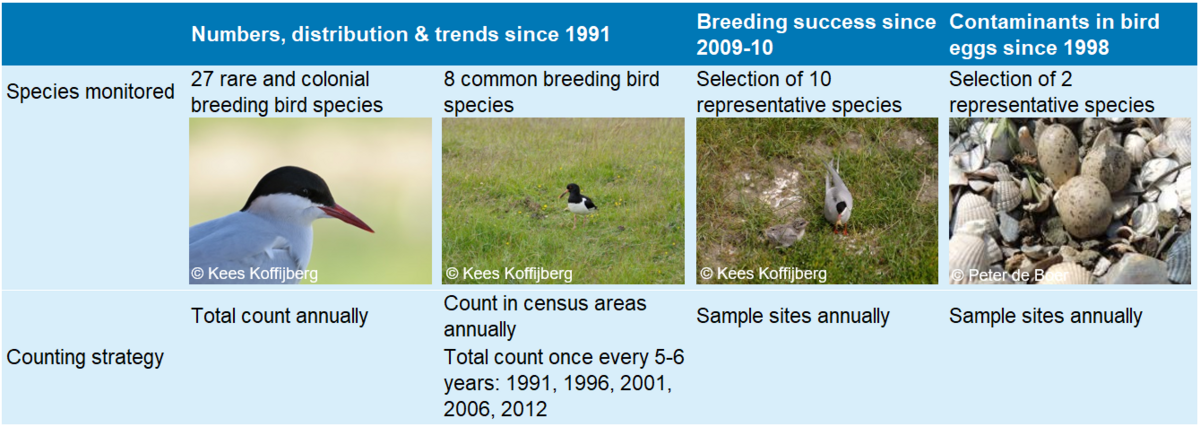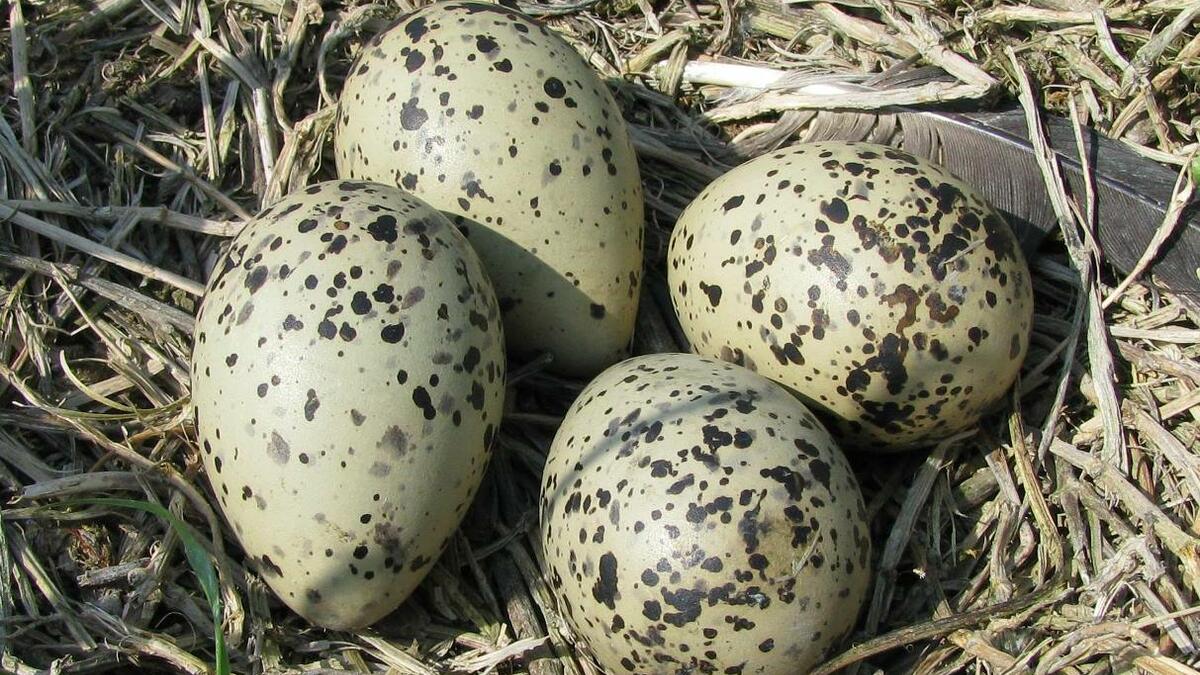
Photo: Peter de Boer. Oystercatcher eggs.
Breeding birds
K. Koffijberg, T. Bregnballe, J. Frikke, B. Hälterlein, M. Bentzon Hansen, J. Meyer, G. Reichert, J. Umland & T. van der Meij
Published 2022
PDF1. Introduction
The Wadden Sea functions as a stop-over, moulting, or wintering site for many bird species, but is also an important breeding area for species like the Common Shelduck, Eurasian Oystercatcher, Common Redshank, Lesser Black-backed Gull, Sandwich Tern, and Common Tern. For breeding Eurasian Spoonbill and Gull-billed Tern, the Wadden Sea is even the most important stronghold in Northwest-Europe. As such, breeding bird data are reviewed frequently on a national level in the context of international conventions, such as the EU Birds Directive, the Marine Strategy Framework Directive, and the African Eurasian Waterbird Agreement. Besides, the data feed into two of the biodiversity indicators of OSPAR (abundance and breeding success, respectively) and give information to various national frameworks.
Even though many of the breeding birds are migrants and winter along the East Atlantic Flyway (e.g. in the Mediterranean or Africa), their abundance on breeding sites in the Wadden Sea is likely closely related to the local conditions and therefore also associated with local management regimes. In this context, the fate of breeding birds in the Wadden Sea has received increased attention in the past decade, as an ongoing decline and poor reproductive success have been observed among characteristic Wadden Sea breeding bird species in the past decade. As a result, various management actions have been undertaken by national and local site managers. Results of the Trilateral Monitoring and Assessment Program (TMAP) have proven valuable to evaluate the success of such measures.
This Quality Status Report (QSR) reviews both the abundance of coastal breeding birds and the observed trends in their numbers. These are evaluated against the targets of the Wadden Sea Plan and discussed in relation to pressures that have affected breeding bird abundance. The data used are mainly derived from the TMAP (Koffijberg et al., 2020), combined with national reports or results from dedicated research projects (references mentioned in the appropriate sections).
Data collection and survey methods
Since 1991, the abundance of 35 coastal breeding bird species has been monitored during the breeding season in the Wadden Sea, using standardized methods in each country and largely harmonized counts among the countries. The trilateral monitoring program aims to carry out complete surveys annually in all rare and colonial breeding birds (e.g. Great Cormorant, Eurasian Spoonbill, Pied Avocet, gulls, and terns) while common breeding birds (e.g. Common Shelduck, Eurasian Oystercatcher, Common Redshank) are counted annually in a set of census areas across the Wadden Sea (Table 1), to provide a representative sample of annual abundance. Once every six years (formerly every five years), a total survey of all 35 breeding bird species is carried out, in order to review total population estimates for common breeding birds at a regular interval. This setup allows the evaluation of trends in numbers as well as (changes in) distribution.
The trilateral dataset, managed by Sovon Vogelonderzoek Nederland in The Netherlands, includes aggregated numbers for each of the 56 counting regions and all the single census areas (see appendix 2 in Koffijberg et al., 2020). National coordinators are responsible for validation and data preparations, before submission to the trilateral dataset. Trend analyses are carried out by Statistics Netherlands (CBS), using established routines for the long-term monitoring scheme for breeding birds in The Netherlands (Boele et al, 2021). Missing counts are accounted for by using imputing techniques. For common breeding birds, trends at the regional level are weighted according to their population share assessed by the total counts (to account for the difference in the number of census areas in each region). Trends have been assessed for the period 1991-2017 (long-term trends) and the period 2006-2017. The latter represent short-term trends and cover a period of 12 years, i.e. two cycles of total counts (as well as two cycles in reporting scheme for birds for the EU Birds Directive). The data used to evaluate the distribution have been derived from the total count in 2012 because the data for 2018 were not yet available at the trilateral level (data still missing for Germany). Trend classifications are standardized, based on the rate of change and its standard error, and similar for breeding birds and migratory birds.
In addition to the monitoring of numbers and distribution, also breeding success has been added as a parameter to the TMAP in 2010 (Thorup & Koffijberg, 2016). Breeding success, in terms of the number of successfully fledged young per breeding pair, is one of the key demographic parameters that can explain observed changes in breeding abundance (the other being annual survival). Only very recently (2021), a trilateral database to manage all breeding success data has been established. For this reason, results presented here have not only been derived from the trilateral report by Thorup & Koffijberg (2016) covering the first years of the scheme but also taken from national reports issued mainly in The Netherlands and covering a much longer period (e.g. Koffijberg et al., 2021). Breeding success is monitored in ten breeding bird species that have been selected by trilateral experts and give a representative sample of species with different habitat and food requirements. The majority of breeding success data is collected in The Netherlands, followed by Schleswig-Holstein and Lower Saxony. In Denmark data were only collected in the first years of the program due to lack of funding.
Table 1: Setup of the TMAP monitoring scheme for breeding birds in the Wadden Sea. For a complete overview, the scheme for contaminants in bird eggs is shown as well, but it is not coordinated by the Expert Group Breeding Birds and not reviewed in this chapter.
Numbers and distribution
During the last total count (2012) that has been processed at the trilateral level, 395,000 breeding pairs were recorded across the 35 species monitored. Among the most abundant species (>10,000 breeding pairs) we find colonial breeders such as the Black-headed Gull, Lesser Black-backed Gull and Herring Gull as well as widely dispersed wader species such as the Eurasian Oystercatcher, Northern Lapwing and Common Redshank (Figure 1). Even if these data refer to a period eight years ago, present data points in the same direction. Rare breeding birds represent a group of species that are relatively new to the Wadden Sea, such as the Little Egret, or species that have suffered long-term declines and have come close to extinction, e.g. the Hen Harrier, Ruff and Dunlin. In addition, some of the rare breeding birds should be regarded as accidental breeders, for instance, the Little Gull and Turnstone. They have never been abundant in the Wadden Sea, as their major breeding range is found north of the Wadden Sea area.
Most species show pronounced distribution patterns throughout the Wadden Sea. During the last available total count, the Wadden Sea in Lower Saxony/Hamburg harboured the largest share of all breeding pairs (42%), followed by The Netherlands (26%), Schleswig-Holstein (25%) and Denmark (8%). In the preceding total count in 2006, the highest numbers were found in the Dutch part of the Wadden Sea (46%), pointing at some changes in the core breeding distribution of several species. At the species level, there often appears to be a gradient in abundance from north to south(west) (Figure 2). Species characteristics for the area north of the Elbe Estuary are for instance the Ruff, Gull-billed Tern, Dunlin, Kentish Plover, Red-breasted Merganser and Arctic Tern. On the contrary, the Little Egret, Eurasian Spoonbill, Common Eider, Eurasian Curlew, Sandwich Tern, Great Cormorant, Hen Harrier and Lesser Black-backed Gull are most abundant in the western part of the Wadden Sea, i.e. in Lower Saxony/Hamburg and in The Netherlands. Distribution patterns are explained by the overall geographical distribution as well as the occurrence of suitable habitats in the respective parts of the Wadden Sea, such as dunes on the barrier islands in The Netherlands and Lower Saxony/Hamburg and coastal wetlands in Schleswig-Holstein.
When comparing islands and mainland breeding sites, it becomes clear that the islands (including the Halligen in Schleswig-Holstein) hold the largest share of the breeding bird populations (Figure 3). Overall, 75% of all breeding pairs in the Wadden Sea are found on the islands and Halligen, and this percentage has hardly changed since 1996 (Figure 3). It is notably colonial breeding birds that are mainly found on the various islands while coastal waders are more equally distributed (Figure 3). There are multiple factors explaining these patterns. Colonial breeding birds generally are more susceptible to human disturbance as well as mammalian predators and therefore tend to breed at more remotely situated sites such as outer sands. Some species (e.g. the Lesser Black-backed Gull or Sandwich Tern) also heavily depend on marine food resources, thus tend to breed on islands where they have to cover shorter distances to their main feeding grounds. An overriding advantage of (most) islands, however, is that they are mostly free from mammalian ground predators (apart from Brown Rats) and thus offer safe breeding sites compared to the mainland. Only islands which are connected with a dam with the mainland, like Rømø and Sylt as well as the Halligen Oland, Langeness and Nordstrand in Schleswig-Holstein do not differ from mainland breeding sites in this context. The importance of predation has increased and is judged as one of the most important factors affecting the breeding opportunities of several of the coastal breeding birds (Leyrer et al., 2019). Predation has also been identified as the most likely cause behind the disappearance of colonial breeding birds from a number of mainland breeding sites, e.g. in Friesland in The Netherlands (Bos et al., 2015).
Furthermore, as mentioned before, some breeding birds are attracted by specific habitats like dunes on the barrier islands, salt marshes along the mainland coast (many wader species) or preferred muddy substrates close to the mainland coast to feed in the intertidal area (Pied Avocet). Especially in Schleswig-Holstein, coastal wetlands support important populations of various species (e.g. Pied Avocet and Kentish Plover).
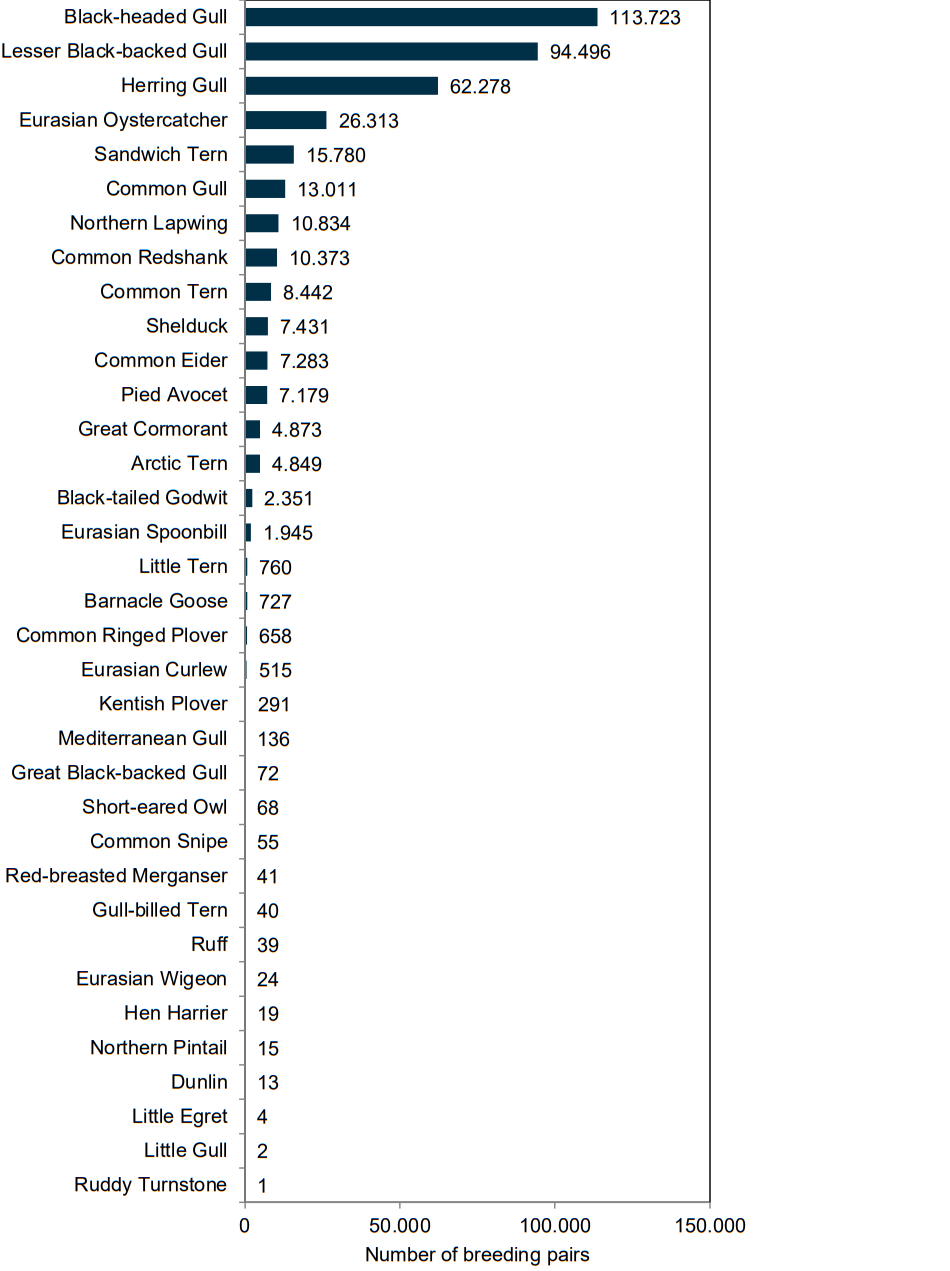 Figure 1: Population size of coastal breeding birds in the Wadden Sea, ranked according to their abundance in 2012.
Figure 1: Population size of coastal breeding birds in the Wadden Sea, ranked according to their abundance in 2012.
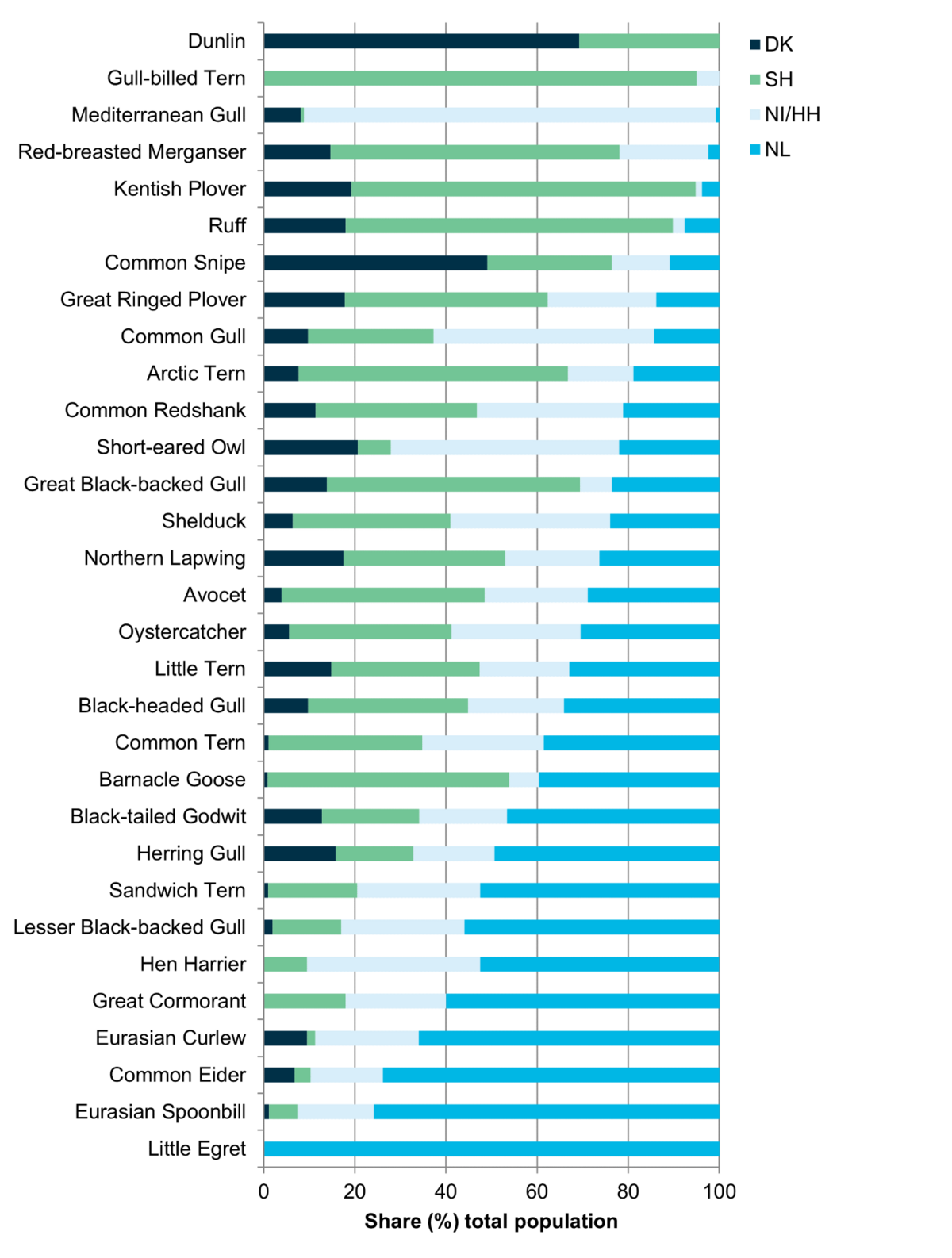 Figure 2: Distribution of coastal breeding birds in the Wadden Sea expressed as their share of the total numbers of breeding pairs in each country (DK Denmark, SH Schleswig-Holstein, NI/HH Lower Saxony and Hamburg, NL The Netherlands). Species are ranked in declining order based on their share in The Netherlands (data 2012).
Figure 2: Distribution of coastal breeding birds in the Wadden Sea expressed as their share of the total numbers of breeding pairs in each country (DK Denmark, SH Schleswig-Holstein, NI/HH Lower Saxony and Hamburg, NL The Netherlands). Species are ranked in declining order based on their share in The Netherlands (data 2012).
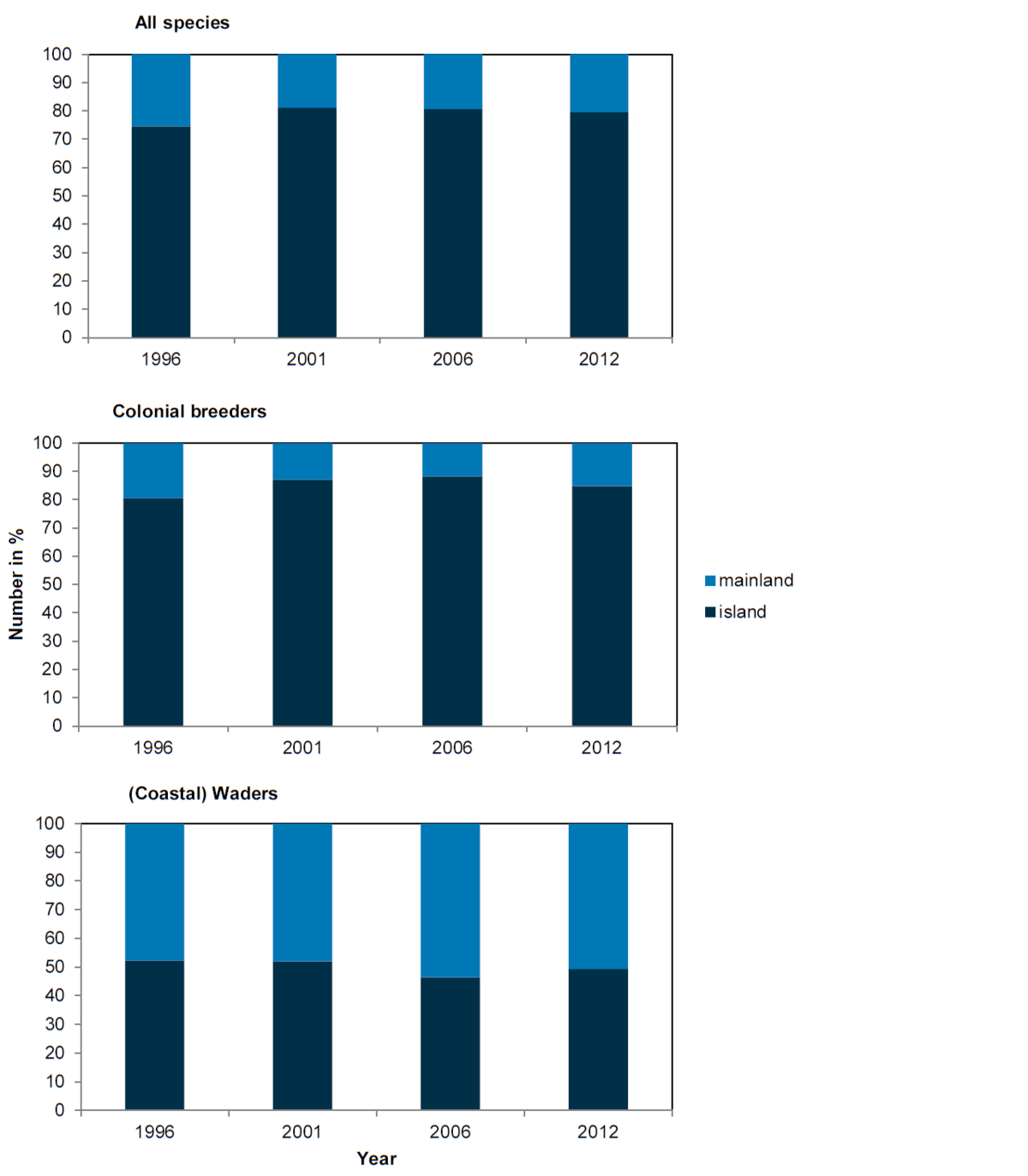 Figure 3: Distribution of coastal breeding birds among islands (incl. Halligen and outer sands) and the mainland coast in the Wadden Sea during the four total counts 1996-2012. Shown are all species and colonial breeders and (coastal) waders separately.
Figure 3: Distribution of coastal breeding birds among islands (incl. Halligen and outer sands) and the mainland coast in the Wadden Sea during the four total counts 1996-2012. Shown are all species and colonial breeders and (coastal) waders separately.
2. Status and trends
For 33 out of 35 breeding bird species, trends could be assessed. For the period 1991-2017, 18 out of 33 species (55%) have experienced significant declines (Figures 4, 5). The highest rates of decline were observed in the Ruff, Hen Harrier and Common Snipe, which currently are found breeding only at a few sites across the Wadden Sea and they may be on the brink of extinction. Furthermore, we found negative trends in a number of abundant and characteristic species such as the Arctic Tern, Common Eider, Kentish Plover, Pied Avocet and Eurasian Oystercatcher. Among the thriving species, breeding birds that are relatively new to the Wadden Sea showed the highest rates of increase, for instance, the Barnacle Goose and Mediterranean Gull, but also the Eurasian Spoonbill (which finished colonization of the Wadden Sea in 2007 in the Danish part).
When looking at the latest 12 years of the data series no major changes are visible, apart from many trends (11 species) becoming non-significant (i.e. uncertain) because of annual variation in numbers combined with the shorter time window for which trends were assessed (Figure 5). For some species, declines or increases in the long term have stabilized over the past 12 years, as observed in e.g. in the Common Shelduck, Common Eider, Black-tailed Godwit, Common Redshank, Black-headed Gull, Lesser Black-backed Gull and Herring Gull. In Kentish Plover, the long term decline has turned into an increase, mainly as a result of developments at important breeding sites in Schleswig-Holstein. In Common Gull, initial declines in the Dutch Wadden Sea have been followed by decreases or stabilizing numbers in other parts of the Wadden Sea, leading to an overall negative trend.
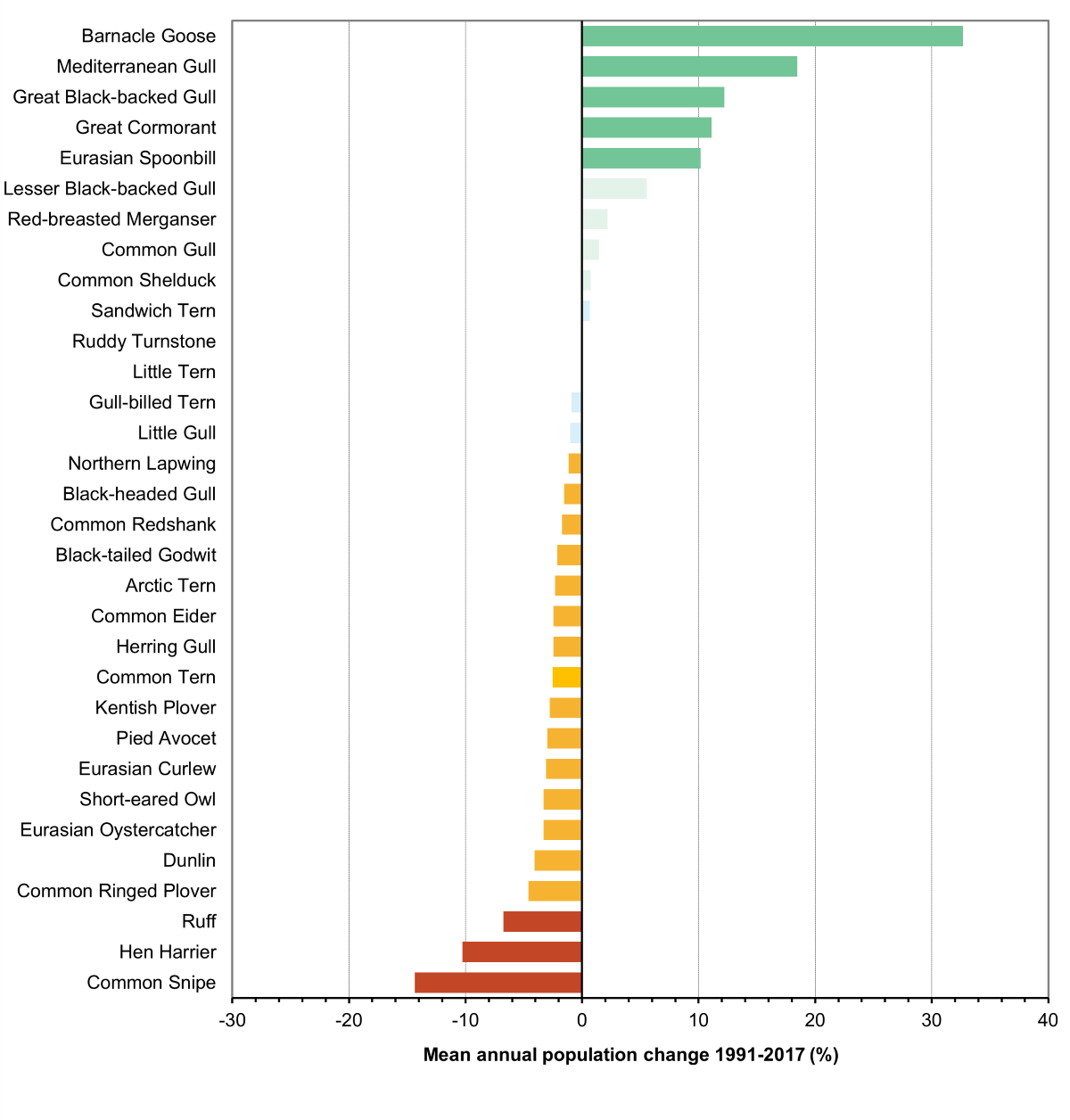 Figure 4: Summary of trend in numbers of breeding birds in the Wadden Sea, ranked according to their annual rate of population change (from top to bottom from strong increase to strong decrease). Green bars denote increases, red bars denote decreases and light blue denotes stable trends (see also Figure 5 for explanation).
Figure 4: Summary of trend in numbers of breeding birds in the Wadden Sea, ranked according to their annual rate of population change (from top to bottom from strong increase to strong decrease). Green bars denote increases, red bars denote decreases and light blue denotes stable trends (see also Figure 5 for explanation).
Within the Wadden Sea, there were profound differences in the trends observed. In the western part of the Wadden Sea, in The Netherlands and Lower Saxony/Hamburg, declines dominated the overall picture (56% and 57% of species considered, Figure 5) whereas in Schleswig-Holstein and Denmark a more balanced population dynamics was observed. For the last 12 years, this pattern sustains in the Dutch Wadden Sea while non-significant (i.e. fluctuating) trends dominate in the other sections. However, still, the number of species showing increases in Denmark and Schleswig-Holstein remains at a higher level compared to Lower Saxony/Hamburg and The Netherlands. Figure 6 shows some examples of species with contrasting (long-term) trends within the Wadden Sea. Further analysis or local studies of such contrasting patterns could be helpful in the process of identifying why diverging patterns have emerged, thereby also generating more knowledge about the factors that have caused breeding bird populations to decline.
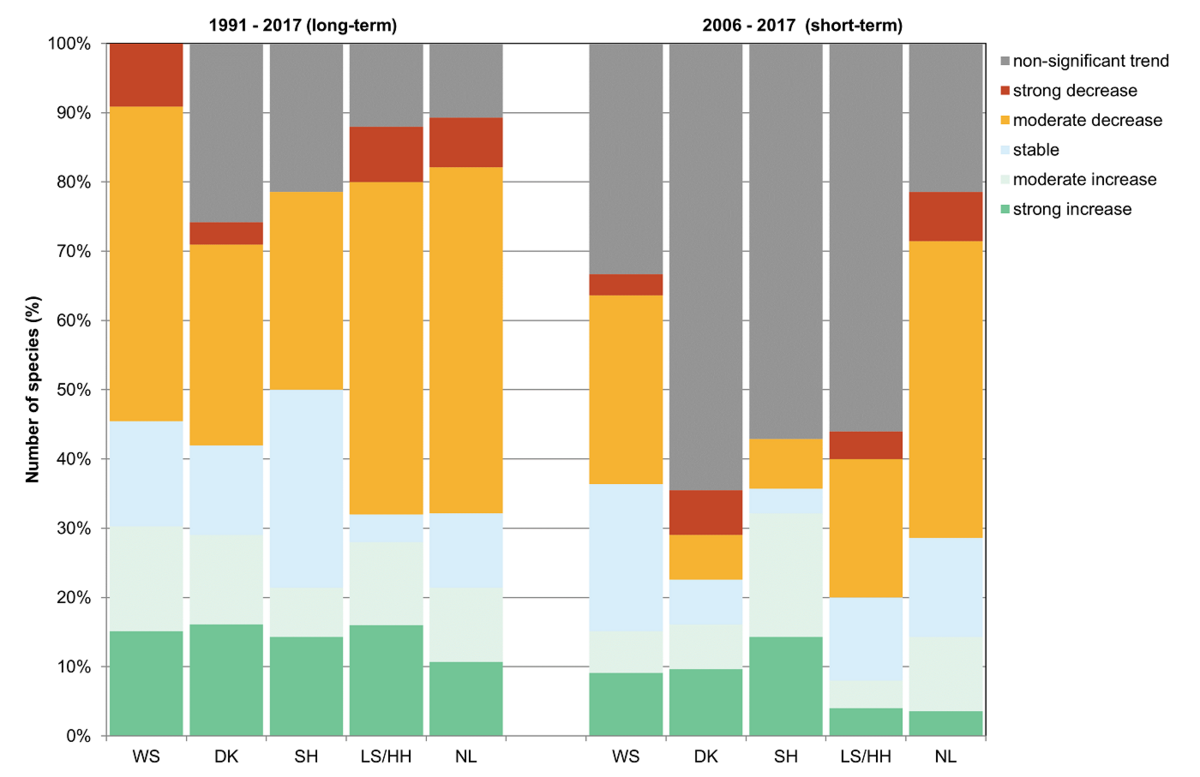 Figure 5. Summary of trends in breeding birds for the Wadden Sea and the respective countries. Shown for the entire data series (1991-2017, long-term) and the last 12 years (2006-2017, short-term). WS denotes the Wadden Sea (for abbreviations of countries see Figure 2).
Figure 5. Summary of trends in breeding birds for the Wadden Sea and the respective countries. Shown for the entire data series (1991-2017, long-term) and the last 12 years (2006-2017, short-term). WS denotes the Wadden Sea (for abbreviations of countries see Figure 2).
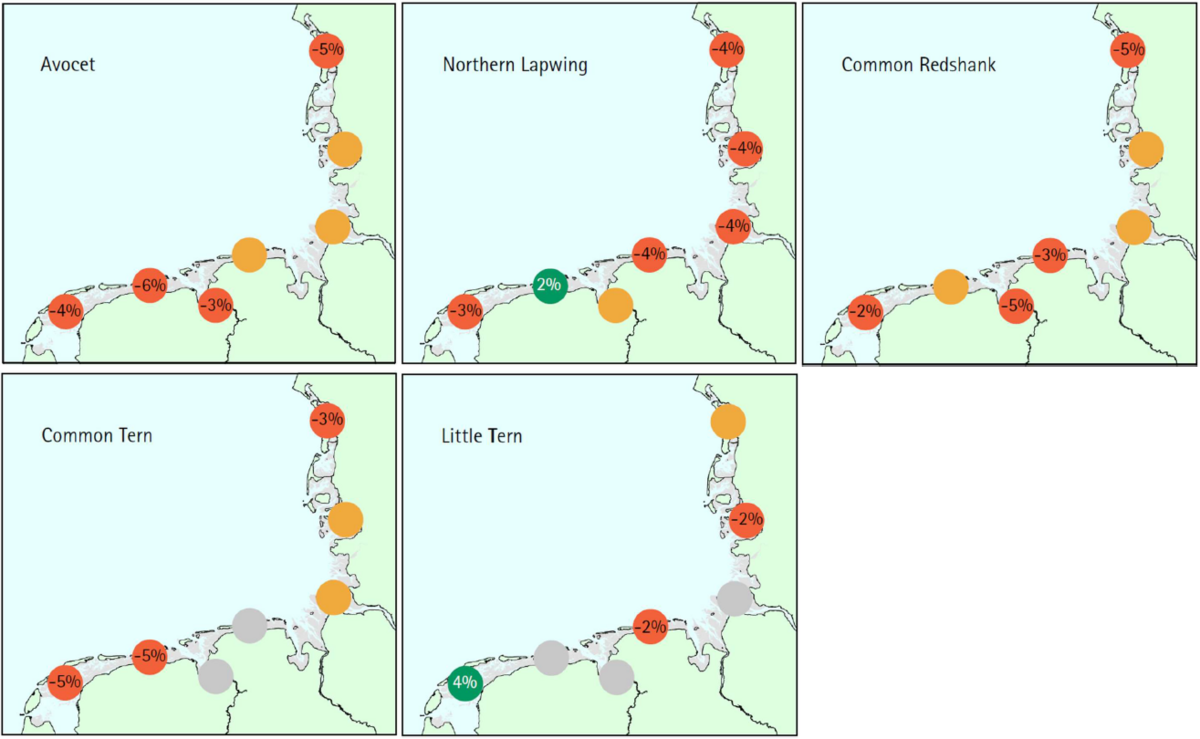 Figure 6. Examples of species for which trends (1991-2017) differ within the Wadden Sea. Colour denotes increase (green), stable (orange) or decrease (red). Uncertain trends are marked in grey. For increasing and decreasing species, the figure shows the annual rate of population change.
Figure 6. Examples of species for which trends (1991-2017) differ within the Wadden Sea. Colour denotes increase (green), stable (orange) or decrease (red). Uncertain trends are marked in grey. For increasing and decreasing species, the figure shows the annual rate of population change.
Especially the migratory part of the breeding bird populations in the Wadden Sea depends on a much wider network of sites, constituting the so-called East-Atlantic Flyway. Hence, changes in abundance observed in the breeding season in the Wadden Sea may also partly be attributed to factors operating in other parts of the flyway rather than being determined solely by drivers operating within the Wadden Sea and only during the breeding season. The Wadden Sea Flyway Initiative (WSFI) addresses this international linkage of the Wadden Sea to other wetland sites within the flyway (van Roomen et al., 2018; See report Flyway).
Overall, there are quite a lot of similarities between trends in abundance in the Wadden Sea and at flyway level (Figure 7). There are six species for which trends in the Wadden Sea were more positive as at flyway level, of which four showed statistically significant trends: in both the Barnacle Goose and Eurasian Spoonbill the increase rate in the Wadden Sea was higher than on flyway level, while for the Herring Gull and Common Redshank stable trends in the Wadden Sea came with decreases at flyway level. In five species, trends in the Wadden Sea pointed at higher rates of decrease (or decrease versus stable trend) than on flyway level: Pied Avocet, Eurasian Curlew, Eurasian Oystercatcher, Common Gull and Common Tern. Strikingly different were especially Pied Avocet, Eurasian Curlew and Common Tern, for which Wadden Sea trends were subject to a decrease whereas at flyway level stable numbers prevailed in these species. Large differences were also found in Kentish Plover, Gull-billed Tern and Little Egret, but in either case, this involved non-significant trends.
 Figure 7. Comparison of trends in abundance in breeding birds in the Wadden Sea and at flyway level. Shown is the average rate of annual population change for the past 12 years (in %), species ranked according to the rate of change in the Wadden Sea. Values above zero depict increases, values below zero depict decreases. Colours denote trend classification (moderate and strong changes merged, see Figure 5).
Figure 7. Comparison of trends in abundance in breeding birds in the Wadden Sea and at flyway level. Shown is the average rate of annual population change for the past 12 years (in %), species ranked according to the rate of change in the Wadden Sea. Values above zero depict increases, values below zero depict decreases. Colours denote trend classification (moderate and strong changes merged, see Figure 5).
Drivers and pressures
The overall picture emerging from the results of the breeding bird monitoring in the Wadden Sea shows that many breeding birds in the Wadden Sea currently experience downward trends, some even more so than at the flyway level. If we compare the latest results with previous QSR assessments, it becomes clear that the number of species in decline has grown over time (see chapter Assessment). Within the trilateral expert groups and among other experts and site managers, backgrounds and causes for this development have been discussed in a number of trilateral workshops (e.g. "Breeding birds in trouble" in 2013 and "Managing predation risk for breeding birds in the Wadden Sea" in 2017; JMBB, 2016, Leyrer et al., 2019). Poor breeding success has been identified as a key driver for the observed declines in most breeding bird species (Van der Jeugd et al., 2014). Changes in annual survival appeared to have caused a decline in population size in only a few of the species (Little Egret, Common Eider, Hen Harrier, Black-headed Gull, Herring Gull).
In a first assessment of breeding success in the Wadden Sea, it was shown that several species failed in producing sufficient offspring to maintain a stable population. Especially Eurasian Oystercatcher, Pied Avocet and Arctic Tern were suffering from overall poor reproduction rates in nearly all parts of the Wadden Sea, both on the islands and along the mainland coast, whereas especially the Eurasian Spoonbill fared much better (Thorup & Koffijberg, 2016). More recent data (until 2019) from the breeding success monitoring scheme in the Dutch Wadden Sea (Koffijberg et al., 2021) point at almost annual breeding failures in the Eurasian Oystercatcher, Pied Avocet, Black-headed Gull and Arctic Tern, and local reports from other parts of the Wadden Sea point at a similar situation for at least Eurasian Oystercatcher and Pied Avocet.
Among the mechanisms for failure in breeding success, (increased) predation risk and flooding have been mentioned as the most important causes for clutches not hatching successfully or chicks not surviving the chick-rearing period (JMBB, 2016; Thorup & Koffijberg, 2016; Koffijberg et al., 2021). The main predators identified to play an important role are mustelids and especially Red Fox, but other 'new' mammalian predators such as Raccoon Dog occur locally and the American Mink emerges on the horizon (Leyrer et al., 2019). These predominantly nocturnal mammals are mainly active at the mainland breeding sites (salt marshes and coastal wetlands) but have also colonized islands connected to the mainland (e.g. Sylt, Rømø, Mandø), or – in cases where the distance to the mainland is short – have crossed the intertidal mudflats (e.g. observed with Red Fox at the island of Norderney in Lower Saxony and at the island of Langli in Denmark). Also, construction works on connections between the mainland and islands have facilitated predators to invade formerly unoccupied areas, as observed on the Halligen of Oland and Langeneß (Leyrer et al., 2019).
Introduced mammalian predators such as Hedgehog and Ferret have also caused losses among coastal breeding birds, as has been shown for the island of Norderney in Lower Saxony (Andretzke et al., 2017). On remote islands, the Brown Rat is periodically abundant, having a detrimental impact on the breeding success of coastal breeding birds (MELUND & LLUR 2018; Leyrer et al., 2019; Koffijberg et al., 2021). In a wider context, predation risk is not only causing direct losses of clutches or low survival of chicks but also results in changes in settlement patterns in mainland breeding sites (further from the dike) or areas becoming completely abandoned by e.g. colonial breeding birds, as the perceived predation risk is too high (Cervencl et al., 2011; Bos et al., 2015). Avian predation is observed as well but is considered not to have similar impacts as mammalian predators (see MELUND & LLUR 2018; Leyrer et al., 2019 for overview).
Flooding risk occurs both along the mainland coast and on islands and has increased in time through a combination of sea-level rise and an increased occurrence of storms during the breeding season (van de Pol et al., 2010). Detailed research on Eurasian Oystercatchers in the Dutch Wadden Sea has shown that the frequency of flooding has affected long-term reproduction (van de Pol et al., 2010) and that individual birds do not seem to respond to increased flooding events, e.g. by altering their choice of nest sites, (Bailey et al., 2017). However, it is not yet known to what extent this also holds true for other bird species as larger-scaled studies are lacking.
Moreover, it should be noted, that breeding failure is often a combination of multiple factors operating in concert. Effects of food availability have been especially studied in colonial breeding birds like the Lesser Black-backed Gull and it has been pointed out that low chick survival can result from decreased offshore feeding opportunities (Camphuysen, 2013). Effects of disturbance have been mainly reported for beach-breeding species such as the Common Ringed Plover, Kentish Plover and Little Tern. They may have an impact on a wider scale and at the population level. However, the aforementioned species have also declined on uninhabited islands and restrictions during the Covid-19 pandemic have not resulted in re-occupation of formerly crowded beach areas (as reported for barrier islands in The Netherlands and Lower Saxony in 2020, R. Kleefstra, G. Reichert, pers. comm.). This implies that the protection of existing breeding sites in these species is even more important than it was already.
3. Assessment
Given the large number of declining breeding bird species and the reported failure of breeding success in many species, only a limited number of breeding birds in the Wadden Sea is currently thriving. Instead, a majority of species shows a downward trend and did not show clear signs of a recovery in recent years (albeit some examples do exist, e.g. the Kentish Plover in coastal wetlands in Schleswig-Holstein). When compared to previous QSRs, it also becomes clear that with every update of the data series, the number of breeding bird species with declining numbers has increased until recently (Figure 8), pointing at ongoing downward numbers in many species (especially at the expense of stable trends). On the other hand, we found no clear trend in the number of species experiencing upward numbers, with only a few exceptions (e.g. Kentish Plover).
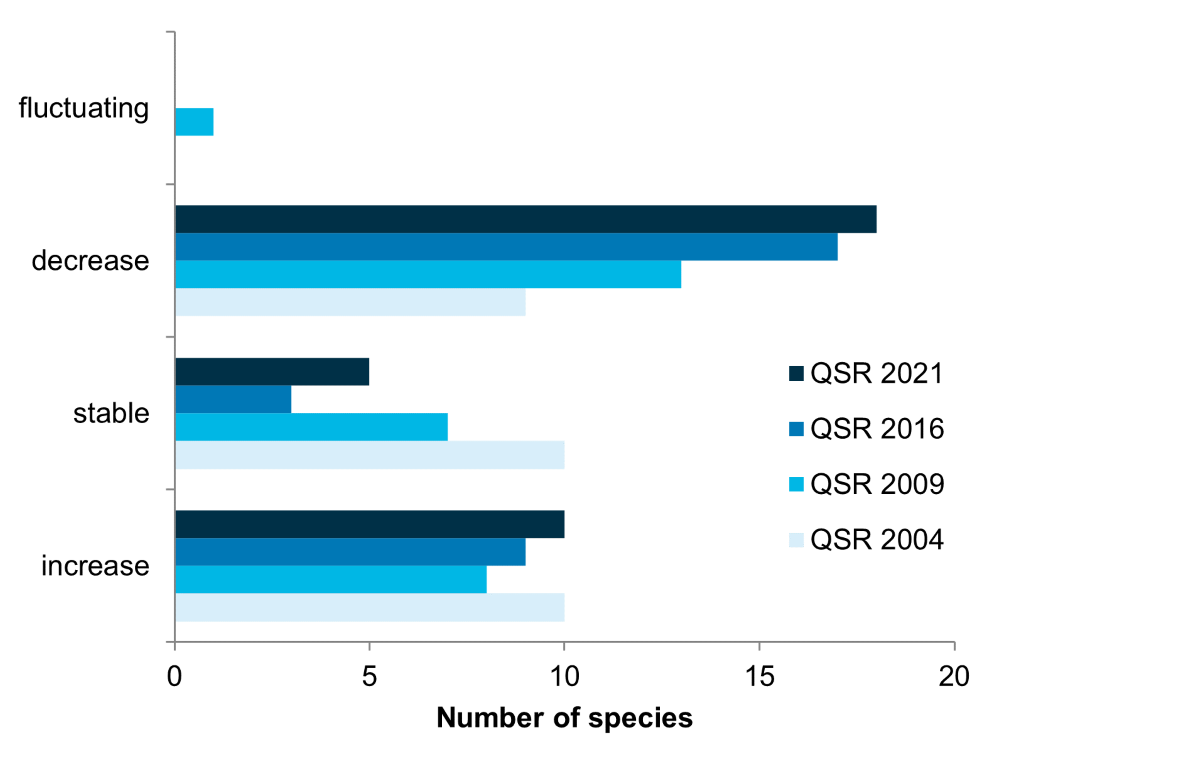 Figure 8: Summary of trends in abundance of breeding birds in the Wadden Sea according to subsequent QSR assessments in 2004, 2009, 2016 and 2021, referring to data from 1991-2001, 1991-2006, 1991-2013 and 1991-2017 respectively.
Figure 8: Summary of trends in abundance of breeding birds in the Wadden Sea according to subsequent QSR assessments in 2004, 2009, 2016 and 2021, referring to data from 1991-2001, 1991-2006, 1991-2013 and 1991-2017 respectively.
In the Wadden Sea Plan, six targets have been identified related to the abundance of breeding and migratory bird populations in the Wadden Sea:
1. Stable or increasing numbers and distribution taking into account that abundance of species is in line with prevailing physiographic, geographic and climatic conditions
This target is clearly not met at present, as 18 out of 33 breeding birds (55%) for which trends could be assessed are subject to long-term declines. There is a lot of evidence that in many of the species the declines are associated with failure of reproduction at breeding sites in the Wadden Sea (see below). However, patterns in both decreasing and increasing species may interact with changes in abundance at a larger scale. In thriving species, this is very obvious for breeding birds that have expanded their breeding range in the past decades, such as the Barnacle Goose, Mediterranean Gull, Lesser Black-backed Gull and Greater Black-backed Gull (and within the Wadden Sea also the Eurasian Spoonbill). Among the declining species, trends in e.g. the Arctic Tern, which reaches its southwestern border of its breeding range in the Wadden Sea, could theoretically point at a northward shift in distribution (Huntley et al., 2007), but there is no evidence yet that such a movement is actually taking place, even if the southernmost fringes of the breeding range indeed seem to have been abandoned more recently (Keller et al., 2020).
2. Breeding success and survival determined by natural processes
This target also is not met. Among ten selected species for which breeding success is monitored, a number of important species is currently producing too few offspring to sustain their population and has done so over a long period of time (as shown for in the Dutch Wadden Sea for the Eurasian
Oystercatcher, Pied Avocet, Black-headed Gull and Arctic Tern). Even if data are not available for all breeding bird species, the main causes for failure (predation and flooding) likely affect other species as well. Within the group of species monitored, the Eurasian Spoonbill is the only species that does not suffer from sustained low breeding success (Koffijberg et al., 2021). For the Dutch Wadden Sea, however, it has been predicted that the population increase will come to an end as a result of density-dependent effects (Lok et al., 2013; Oudman et al., 2017).
Annual survival does play a role in a number of species (van der Jeugd et al., 2014) but seems a less general issue. However, monitoring of survival is not part of the current monitoring program and assessments, therefore, depend on periodical analyses, as carried out by Van der Jeugd et al. (2014) in the Dutch Wadden Sea (to be repeated in 2025-2026). For those species for which annual survival contributed to the observed trends, food availability was an important driver (Camphuysen, 2013; Van der Jeugd et al., 2014), with the Little Egret being an exception. This species expansion is limited by the occurrence of cold winters, causing high mortality (Kleefstra et al., 2009). If the tendency for warmer winters continues, this species will benefit, but a cold winter every now and then may put it back to lower levels of abundance.
Predation is a natural phenomenon, but the dynamics in the distribution of predator abundance have been influenced by man or man-made changes in the environment (Leyrer et al., 2019) whereas sea level rise is a result of human-induced global climate change.
3. Breeding, feeding, moulting and roosting sites supporting a natural population
Considering the poor breeding success and the large number of species showing decreasing numbers, the available monitoring data suggest that this target is not met (regarding breeding birds), but additional data is needed from other surveys to give a full assessment.
4. Undisturbed connectivity between breeding, feeding, moulting and roosting sites
This target is mainly associated with migratory bird data, see Migratory Birds Report.
5. Fluctuations in food stocks determined by natural processes
This target is difficult to assess based only on information from the breeding birds monitoring scheme. There is evidence that some breeding bird species, e.g. the Herring Gull and Lesser Black-backed Gull, have benefited from over-abundant food resources (rubbish dumps and fishery discards respectively, Camphuysen, 2013) in the past and now – as those resources have become limited – respond with periodic breeding failure and lower abundance. Similar evidence also exists for many herbivorous bird species such as the Barnacle Geese, which have benefited from improved feeding conditions in agriculturally managed areas (e.g. Fox & Abraham, 2017). In fish-eating species, several studies have pointed at changes in fish abundance and behaviour due to climate-driven changes in the marine environment (e.g. Dänhardt & Becker, 2010).
6. Habitat, food stocks and connectivity between habitats supporting a favourable conservation status
Given the overall pattern of reduced abundance and poor breeding success this target is not met, but it should be emphasized that this target would also benefit from a clearer definition of a "favourable conservation status". Among the existing international conventions, this is subject to different interpretations and within the Wadden Sea, the individual countries have implemented this differently in the context of the EU Bird Directive, making it difficult to assess this target.
4. Recommendations
The main aim of the breeding-bird monitoring program in the Wadden Sea is to identify signals about the fate of breeding bird populations and by doing so, initiate management action and further research to unravel the causes of the observed changes in abundance. The design of the current monitoring scheme has proven to be successful in doing so (see Numbers and Distribution in the Introduction and Chapter 2) but can be improved by speeding up the data available at the trilateral level and thus becoming more up-to-date. This applies to both the data on trends and those from the total counts once every six years. For Denmark and The Netherlands such recent data are already available, usually lagging only one year behind. As a result, the regular progress reports on breeding bird numbers and trends would be able to pinpoint at developments (negative as well as positive) at an earlier stage. Furthermore, investigations in new census techniques (notably the application of drones) and tackling pitfalls in species difficult to count (e.g. the Common Eider) would improve the existing census scheme and increase the data quality and could be addressed in the ongoing so-called Quality Assurance Meetings.
Inclusion of the parameter breeding success within TMAP has attracted attention to the poor reproductive performance of breeding birds in the Wadden Sea (JMBB, 2013) and its consequences and has also prompted a series of conservation and management measures in all parts of the Wadden Sea, for instance with a national breeding bird action plan for the Dutch Wadden Sea (Programma Rijke Waddenzee, 2018). However, only very recently a database setup in which all trilateral breeding success data can be managed was established in conjunction with a revision of the data routines in the Dutch Wadden Sea, as resources at the trilateral level are limited to undertake such coordinated initiatives. Following the earlier report in 2015, the new dataset will enable an overview of more recent data on breeding success in the whole Wadden Sea (albeit that data is not collected in Denmark). Changes in management or projects to improve breeding conditions should preferably also be associated with breeding success monitoring (thereby supporting the trilateral setup) as abundance levels may change positively at first sight, but when not accompanied by favourable reproductive output will not sustain. Also, colour-marking will assist in gaining knowledge about the dispersion of breeding birds, as newly created sites or improved breeding conditions may just attract breeding birds from nearby sites and not improve overall abundance at a larger scale. Such a setup is currently working in the framework of the "Wij en Wadvogels" project in the Dutch Wadden Sea, but in many other projects such work is lacking and evaluation relies entirely on monitoring of numbers.
Only recently, studies have started to investigate how predators use habitats inhabited by coastal breeding birds and interact with breeding birds and how this knowledge can be transferred to dedicated measures to reduce losses caused by mammalian predation, beyond known opportunities to engage predation risk with habitat measures like re-wetting (Leyrer et al., 2019). Still, however, many of such studies operate at a small and local level and there is no overall framework for the exchange of information and guidance within the Wadden Sea Cooperation, especially at the level of site managers. Also when it comes to practical implementation (e.g. removal of predators), national legislation differs between, or even within countries, making it difficult to achieve one (trilateral) vision on how to proceed in these issues and leading to several initiatives aiming for similar goals but working independently from each other.
The role of food availability in the fate of Wadden Sea breeding birds is currently less well known and mainly studied at the local level. Studies on e.g. large gulls at the island of Texel (Camphuysen, 2013), Sandwich Terns on the island of Griend (Stienen, 2016), Common Terns at Banter See in Wilhelmshaven (Vedder et al. 2017; 2019) and Common Tern and Arctic Tern in Schleswig-Holstein (V. Hennig, unpublished) have shown the impact of limiting food resources, but many more studies are needed to investigate whether aspects like predation or flooding are really overriding issues, or whether more hidden aspects such as food limitation interact or even act as main drivers for the observed population changes (and how these are influenced by e.g. more overall changes in nutrient input). The same applies to the resilience of breeding birds (and their breeding habitat) towards overall global challenges like sea-level rise, pollution and changes in environmental conditions due to climate change.
At present, islands host the largest part of the breeding bird populations in the Wadden Sea (dependent on species as well), and in the context of the emerging predation issues, it is increasingly important to keep the status of the presently safe breeding sites and take actions to minimize the risk of immigration of predators to islands (also by transfer of goods and materials, e.g. a known transfer route for Brown Rat).
5. Summary
The results of the trilateral breeding bird monitoring in the Wadden Sea show that 55% of the breeding bird populations have experienced significant declines over the last years. The highest rates of decline were observed in the Ruff, Hen Harrier, and Common Snipe, which currently are found breeding at only a few sites across the Wadden Sea. Negative trends were also observed in several abundant and characteristic species such as the Arctic Tern, Common Eider, Kentish Plover, Pied Avocet, and Eurasian Oystercatcher. Poor breeding success has been identified as a key driver for the observed declines in most breeding bird species, while changes in annual survival appeared to have caused declines in only a few species. Predation risk and flooding have been mentioned as the most important causes for clutches not hatching successfully or chicks not surviving the chick-rearing period, but food availability and human disturbance may also play a role. Interestingly, breeding birds that are relatively new to the Wadden Sea showed the highest rates of increase, including Barnacle Goose and Mediterranean Gull, but also the Eurasian Spoonbill.
Within the Wadden Sea, profound differences were observed in numbers and trends. In the Netherlands and Lower Saxony/Hamburg population declines dominated the overall picture (56% and 57% of species considered) whereas in Schleswig-Holstein and Denmark more balanced population dynamics were observed. Further analysis or local studies on contrasting patterns could provide insights into the underlying processes, thereby generating knowledge about the factors that drive population declines and possibilities for adaptive management measures. Changes in management or projects to improve breeding conditions should preferably be associated with breeding success monitoring as positive changes in abundance may not be sustainable, if not accompanied by a favourable reproductive output. Color-marking will assist in gaining knowledge about the dispersion of breeding birds, as improved breeding conditions may simply attract breeding birds from nearby sites and not improve overall abundance at a larger scale. An overall framework for the exchange of information and guidance, especially at the level of site managers, is needed to ensure the knowledge gained at the local level is shared trilaterally.
About the authorsK. Koffijberg 1, T. Bregnballe 2, J. Frikke 3, B. Hälterlein 5, M. Bentzon Hansen 6, J. Meyer 7, G. Reichert 8, J. Umland 9 & T. van der Meij 10
1 Sovon Vogelonderzoek Nederland, Toernooiveld 1, NL-6503 GA Nijmegen, NL. kees.koffijberg@sovon.nl 2 Aarhus University, Department of Ecoscience - Wildlife Ecology, Grenåvej 14, DK - 8410 Rønde, DK. tb@ecos.au.dk 3 Nationalpark Vadehavet, Havnebyvej 30, DK - 6792 Rømø, DK. jofri@nst.dk 4 Schutzstation Wattenmeer, Nationalparkhaus Husum, Hafenstraße 3, 25813 Husum, DE. b.gnep@schutzstation-wattenmeer.de 5 Nationalparkverwaltung Schleswig-Holsteinisches Wattenmeer, Schloßgarten 1, 25832 Tönning, DE. bernd.haelterlein@lkn.landsh.de 6 Miljø- og Fødevareministeriet, Miljøstyrelsen, Skovridervej 3, Arnum, 6510 Gram, DK. mobha@svana.dk 7 Freie und Hansestadt Hamburg, Behörde für Umwelt, Klima, Energie und Agrarwirtschaft, Neuenfelder Straße 19, 21109 Hamburg, DE. julia.meyer@bukea.hamburg.de 8 Nationalparkverwaltung Niedersächsisches Wattenmeer, Virchowstr. 1, 26382 Wilhelmshaven, DE. gundolf.reichert@nlpv-wattenmeer.niedersachsen.de 9 Mühlenstraße 3, 25870 Oldenswort, DE. jens.umland@t-online.de 10 Statistics Netherlands (CBS), Henri Faasdreef 312, 2492 JP The Hague, NL. t.vandermeij@cbs.nl |
References
Andretzke, H., Voßkuhl, M., Berndt, A., Bruzinski, J., Hermann, J. & Reichert, G., 2017. Säugetiere als Gelege- und Kükenprädatoren auf den Ostfriesischen Inseln Norderney, Borkum und Langeoog. Natur- und Umweltschutz 16 (2): 59-66.
Bailey, L.D., Ens, B.J., Both, C., Heg, D., Oosterbeek, K., van de Pol, M., 2017. No phenotypic plasticity in nest-site selection in response to extreme flooding events. Phil.Trans. R. Soc. B 372: 20160139.
Boele, A., van Bruggen, J., Hustings, F., van Kleunen, A., Koffijberg, K., Vergeer, J.W. & van der Meij, T., 2021. Broedvogels in Nederland in 2019. Sovon-rapport 2021/02. Sovon Vogelonder zoek Nederland, Nijmegen.
Bos, D., Engelmoer, M., Feddema, J. & Koffijberg, K., 2015. Broedvogels van Noord-Friesland Buitendijks en de invloed van verkweldering op hun aantallen. Limosa 88: 31-42.
Camphuysen, C.J., 2013. A historical ecology of two closely related gull species (Laridae): multiple adaptations to a man-made environment. PhD Thesis, Univ. of Groningen, Groningen.
Cervencl, A., Esser, W., Maier, M., Oberdiek, N., Thyen, A., Wellbrock, A. & Exo, K-M., 2011. Can differences in incubation patterns of Common Redshanks Tringa totanus be explained by variations in predation risk? J Ornithol 152: 1033–1043.
Dänhardt, A. & Becker, P.H., 2010. Die Bedeutung umweltbedingter Verteilungsmuster von Schwarmfischen für Seevögel im Ökosystem Niedersächsisches Wattenmeer. Abschlussbericht des Projektes 53-NWS-41/04 der Niedersächsischen Wattenmeerstiftung. Wilhelmshaven.
Fox, A.D. & Abraham, K.F., 2017. Why geese benefit from transition from natural vegetation to agriculture. Ambio 46 (Supplement): S188-S197.
Hälterlein, B., Fleet, D.M., Henneberg, H.R., Mennebäck, T., Rasmussen, L-M., Südbeck, P., Thorup, O. and Vogel, R.L., 1995. Anleitung zur Brutbestandserfassungen von Küstenvögeln im Wattenmeerbereich. Wadden Sea Ecosystem No. 3. Common Wadden Sea Secretariat, Wilhelmshaven.
Huntley, B., Green, R.E., Collingham, Y.C. & Willis, S.H., 2007. A climatic atlas of European breeding birds. Durham University, RSPB, Lynx Edicions, Barcelona.
van der Jeugd, H.P, Ens, B.J., Versluijs, M. & Schekkerman, H., 2014. Geïntegreerde monitoring van vogels van de Nederlandse Waddenzee. Vogeltrekstation rapport 2014-01. Vogeltrekstation, Wageningen; CAPS-rapport 2014-01; Sovon-rapport 2014/18, Sovon Vogelonderzoek Nederland, Nijmegen.
JMBB, 2016. Breeding birds in trouble. A framework for an action plan in the Wadden Sea. CWSS, Wilhelmshaven.
Keller, V., Herrando, S., Vorisek, P., Franch, M., Kipson, M., Milanesi, P., Marti, D., Anton, M., Klvanova, A., Kalyakin M.V., Bauer, H.G. & Foppen, R.P.B., 2020. European breeding bird atlas 2. EBCC and Lynx Edicions, Barcelona.
Kleefstra, R., Horn, H., Leopold, M. & Overdijk, O., 2009. Kleine Zilverreigers in de Waddenzee. Van mediterrane verschijning naar een Nederlandse wadvogel. Limosa 82: 158-170.
Koffijberg, K., Schrader, S. & Hennig, V., 2011. TMAP Manual breeding success, 2nd version 2011. Common Wadden Sea Secretariat, Wilhelmshaven.
Koffijberg, K., Bregnballe, T., Frikke, J., Gnep, B., Hälterlein, B., Hansen, M.B., Körber, P., Reichert, G., Umland, J. & van der Meij, T., 2020. Breeding birds in the Wadden Sea: trends 1991-2017 and results of total counts in 2006 and 2012. Wadden Sea Ecosystem No. 40. CWSS / JMBB, Wilhelmshaven, Germany.
Koffijberg, K., de Boer, P., Geelhoed, S.C.V., Nienhuis, J., Schekkerman, H., Oosterbeek, K. & Postma, J., 2021. Breeding success of coastal breeding birds in the Wadden Sea in 2019. Statutory Research Tasks Unit for Nature & the Environment, WOt Technical Report 183, Sovon Report 2021/40, Wageningen Marine Research Report C069/20.
Leyrer, J., Frikke, J., Hälterlein, B., Koffijberg, K., Körber, P. & Reichert, G., 2019. Managing predation risk for breeding birds in the Wadden Sea. Results from a workshop in Tönning, Schleswig-Holstein, 7-8 March 2017.Wadden Sea Ecosystem No. 38. Common Wadden Sea Secretariat, Joint Monitoring Breeding Bird Group (JMBB) in the Wadden Sea, Wilhelmshaven, Germany.
Lok T., Overdijk, O., Tinbergen, J.M. & Piersma, T., 2013. Seasonal variation in density dependence in age-specific survival of a long-distance migrant. Ecology 94: 2358-2369.
MELUND & LLUR, 2018. Prädationsmanagementskonzept Schleswig-Holstein, MELUND, Kiel.
Oudman T., de Goeij, P., Piersma, T. & Lok, T., 2017. Colony-breeding Eurasian Spoonbills in The Netherlands: local limits to population growth with expansion into new areas. Ardea 105, doi:10.5253/arde.v105i2.a2.
van de Pol, M., Ens, B.J., Heg, D., Brouwer, L., Krol, J., Maier, M., Exo, K-M., Oosterbeek, K., Lok, T., Eising, C.M. & Koffijberg, K., 2010. Do changes in the frequency, magnitude and timing of extreme climatic events threaten the population viability of coastal birds? Journal of Applied Ecology 47: 720-730.
Programma Rijke Waddenzee, 2018. Actieplan Broedvogels Nederlandse Waddenzee. PRW, Leeuwarden.
van Roomen, M., Nagy, S., Citegetse, G. & Schekkerman, H., 2018 (eds). East Atlantic Flyway Assessment 2017: the status of coastal waterbird populations and their sites. WSFI, CWSS/Germany, Wetlands International/The Netherlands, BirdLife International/UK.
Stienen, E.W.M., 2006. Living with gulls. Trading off food and predation in the Sandwich Tern Sterna sandvicensis. PhD Thesis, University of Groningen, Groningen.
Thorup, O. & Koffijberg, K., 2016. Breeding success in coastal breeding birds in the Wadden Sea in 2009-2012. A review. Wadden Sea Ecosystem. Common Wadden Sea Secretariat, Joint Monitoring Group of Breeding Birds in the Wadden Sea, Wilhelmshaven, Germany.
Thyen, S., Büttcher, H., & Exo, K.-M., 2005. Nistplatzwahl von Rotschenkeln Tringa totanus im Wattenmeer: Konsequenzen für Reproduktion, Prädation und Salzwiesen Management. Die Vogelwelt 126: 365-369.
Vedder, O., Zhang, H. & Bouwhuis, S., 2017. Early mortality saves energy: estimating the energetic cost of excess offspring in a seabird. Proc. R. Soc. B 284: 20162724.
Vedder, O., Zhang, H., Dänhardt, A. & Bouwhuis, S., 2019. Age-specific offspring mortality economically tracks food abundance in a piscivorous seabird. A. Nat. 193: 588-597.
This report should be cited as: Koffijberg K., Bregnballe T., Frikke J., Hälterlein B., Bentzon Hansen M., Meyer J., Reichert G., Umland J. & van der Meij T. (2022) Breeding birds. In: Wadden Sea Quality Status Report. Eds.: Kloepper S. & Meise K., Common Wadden Sea Secretariat, Wilhelmshaven, Germany. Last updated 06.09.2022. Downloaded DD.MM.YYYY. qsr.waddensea-worldheritage.org/reports/breeding-birds
All 2022 reports may be cited collectively as: Kloepper S., Bostelmann A., Bregnballe T., Busch J.A., Buschbaum C., Deen K., Domnick A., Gutow L., Jensen K., Jepsen N., Luna S., Meise K., Teilmann J. & van Wezel A. (2022) Wadden Sea Quality Status Report. Common Wadden Sea Secretariat, Wilhelmshaven, Germany. Downloaded DD.MM.YYYY. qsr.waddensea-worldheritage.org

